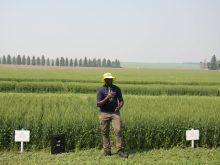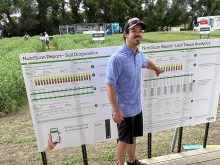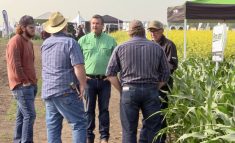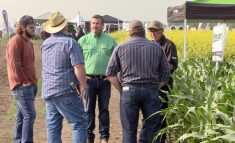Product can be broadcast before planting a canola crop or blended with an additional nitrogen fertilizer such as ESN
A high-nitrogen, low-sulphur fertilizer designed to limit volatilization and leaching is being produced at a Saskatoon facility that was recently commissioned by Northern Nutrients.
The product is called Triple Kick and can be broadcast preceding a canola crop, or blended with an additional nitrogen product like ESN or a coated urea for crops that aren’t as sulphur demanding including cereals.
It consists of 38 percent nitrogen, 18 percent sulphur, a source of carbon and two nitrogen stabilizers evenly dispersed through the prill.
Ross Guenther of Northern Nutrients said the company started developing Triple Kick in 2019 with compatibility testing of nitrogen stabilizers and sources of carbon.
Read Also

Dry bean seeded acreage in Manitoba hits 20-year high
Dry bean acreage across all types reached around 207,000 acres in 2025, representing a significant increase from last year’s 182,000 acres.
The research was assisted by the National Research Council of Canada Industrial Research Assistance Program.
“When the (fertilizer) plant went operational, we combined that research on essentially carbon and nitrogen stabilizers together with sulphur and nitrogen, to make what I would call a world-first product that has nitrogen stabilizers, sulphur and carbon, which all prevent volatilization in a single prill,” Guenther said.
Triple Kick uses the two most common nitrogen stabilizers, dicyandiamide (DCD) and N (n-Butyl) thiophosphoric triamide (NBPT).
The carbon sources, which Guenther said also helps prevent volatilization, is derived from trees and is a byproduct of the paper and pulp industry.
DCD and NBPT stabilizers are an established technology, whereas there are multiple companies that recently developed products that use sulphur and nitrogen together, because sulphur can help hold the positively charged ammonia ion stable.
“Sulphur and carbon both have that same effect of actually holding that ammonia ion stable in the prill,” Guenther said.
“It reduces the amount of volatilization and denitrification that takes place. So basically, we’ve created a way to put three active ingredients that all have a positive effect on stopping volatilization.”
Triple Kick is being marketed as a spreading product including for top dressing, although the company will conduct research next spring on applying it with air seeders.
“We’ve been selling it strictly as a spreading product to take full advantage of the technology because that’s really where it shines is preventing volatilization with those three active ingredients,” Guenther said.
“We’re almost sold out for this fall. The typical spreading season in Saskatchewan is kind of the September through to early November period.”
He said Triple Kick can help Canadian agriculture reduce greenhouse gas emissions.
“Canada should be thought of, Western Canada specifically, as ground zero for probably the most sustainable farming there is in the world. This product is just another example of some of the great things that are coming out of Western Canada,” Guenther said.
Northern Nutrients produces Triple Kick in its manufacturing facility outside of Saskatoon. The facility uses Shell Thiogro technology, a patented process for the incorporation of micronized elemental sulphur into urea.
At this facility, Northern Nutrients also manufactures a fertilizer called Arctic S, which is a 11-0-0-75 enhanced sulphur urea fertilizer.
Producers can source Triple Kick from multiple farm input retailers.


















